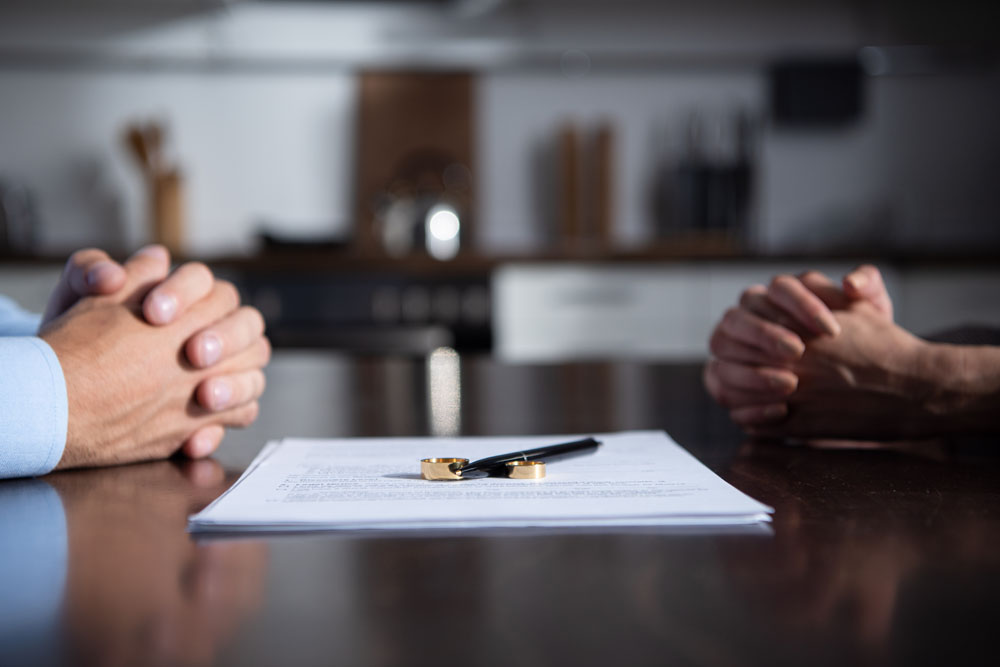Going through a divorce can feel overwhelming, but understanding the process can help to ease some of the stress. Here’s a step-by-step guide to support you through this significant life change.

What is the divorce process?
In April 2022, new no-fault divorce rules replaced the old fault-based system in England and Wales. These changes mean:
- There is no longer a need to establish a “ground” or reason for divorce. Instead, a simple statement of marriage breakdown is required.
- Joint applications are now possible, allowing both parties to apply together, reducing hostility and surprises.
You can now obtain a divorce without attending court by applying online via the government portal. The forms are designed to be straightforward, or you can choose to seek legal assistance.
Before starting, decide whether to apply as a sole applicant or jointly with your spouse. Joint applicants will complete the paperwork together, with the roles of “Applicant 1” and “Applicant 2.” If one party can no longer cooperate, joint applications can switch to individual applications, but not vice versa.
The process begins with the divorce application, which leads to the court issuing a Conditional Order, followed by a Final Order that officially ends the marriage.
How long does a divorce process take?
The divorce process takes a minimum of six months, due to:
- A mandatory 20-week cooling-off period, starting when the application is made. This reflection period allows couples to agree on future arrangements.
- A further six-week wait after the Conditional Order to apply for the Final Order.
However, resolving financial arrangements before applying for the Final Order may extend the timeline.
How do I choose a family lawyer for my divorce process?
Choosing the right family lawyer is crucial to ensure you feel supported. Many people select a solicitor based on recommendations, but it’s also worth checking their credentials, such as membership in Resolution, which promotes constructive family dispute resolution.
You can also explore reviews on platforms like Legal 500 or Chambers Guide to evaluate their expertise. Before deciding, consider informal discussions with potential solicitors to find someone who communicates well, listens to your concerns, and inspires confidence.

Step-by-Step Divorce Process
Step 1: Confirm Eligibility for Divorce in England and Wales
To apply for a divorce, ensure that:
- You’ve been married for more than 12 months.
- Your marriage is recognised in the UK (including same-sex marriages and civil partnerships).
- Your marriage has irretrievably broken down.
Step 2: Plan Key Arrangements
Consider practical matters early on:
- Children: If you agree on arrangements, document them in a Parenting Plan or formalise them with a joint Child Arrangements Order. If unresolved, mediation can help. Failing that, you can apply to the court for a Child Arrangements Order.
- Finances: Financial agreements can be negotiated directly, through mediation, or with legal guidance. To make these legally binding, prepare a Financial Consent Order. This prevents future financial claims and ends financial ties.
Step 3: Start the Divorce Process Application
The application process can be completed:
- Online via Gov.uk.
- By post using Form D8. You’ll need:
- Your marriage certificate (original or certified copy). Provide a certified translation if it is not in English.
- Full names and addresses of both parties.
For joint applications, Applicant 1 starts the process, followed by Applicant 2 filling in their details. The court fee is £593, usually paid by Applicant 1. For joint applications, couples can decide how to split the fee.
Step 4: Court Process, as part of your divorce process
For sole applications, the court sends your spouse (the Respondent) the divorce petition and an Acknowledgement of Service (AOS) form. The Respondent has 14 days to confirm receipt. They can only contest the application for technical reasons, such as a lack of legal recognition for the marriage.
Step 5: Reflection Period
The 20-week reflection period starts upon application. Use this time to agree on practical arrangements, such as finances or child arrangements.
Step 6: Apply for the Conditional Order
After the reflection period, apply for the Conditional Order (previously called the Decree Nisi). If you applied online, this can also be done online.
Step 7: Court Review
The court reviews your Conditional Order application. If approved, you’ll receive a Certificate of Entitlement, which confirms the date the Conditional Order will be pronounced in court.
Step 8: Second Wait Period
After receiving the Conditional Order, wait six weeks and one day before applying for the Final Order. During this period, finalise financial agreements and submit a Financial Consent Order for court approval if needed.
Step 9: Apply for the Final Order
Once the six-week waiting period is over, you can apply for the Final Order (formerly called the Decree Absolute). This document legally ends your marriage. Keep it safe, as it serves as proof of divorce and is needed for future legal purposes, like remarrying.

Why Choose Vaitilingam Kay To Start Your Divorce Process?
At Vaitilingam Kay, we are dedicated to providing tailored and empathetic support during what can often be one of the most challenging times in your life. Here’s what sets us apart:
- Honesty at Every Step: We start with a no-charge, exploratory call to discuss your case. If we can’t add value, we won’t proceed. Honesty and integrity are at the core of our reputation.
- Help You Find Agreement Where Possible: A constructive approach is better for the entire family, both emotionally and financially. We aim for a swift, civilised resolution, helping you assess the value and likely costs at each stage.
- Fight When Needed: Some cases simply cannot be settled. With a decade of experience handling high-profile and hard-fought cases, we are highly skilled litigators who know when and how to press forward effectively.
The divorce process can be challenging and emotional, but you don’t have to face it alone. At Vaitilingam Kay, our team is highly experienced in supporting individuals through relationship breakdowns. We are recommended by the Legal 500 and are here to provide the legal advice and guidance you need to navigate the process as smoothly as possible. For further information or to discuss your situation, please get in touch with us today.